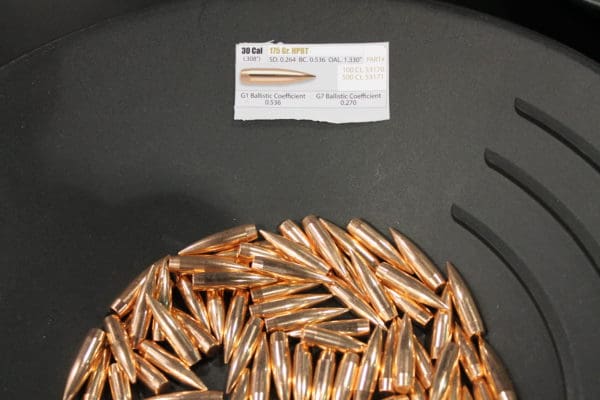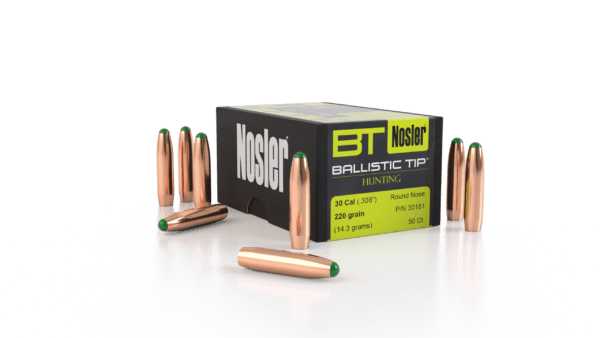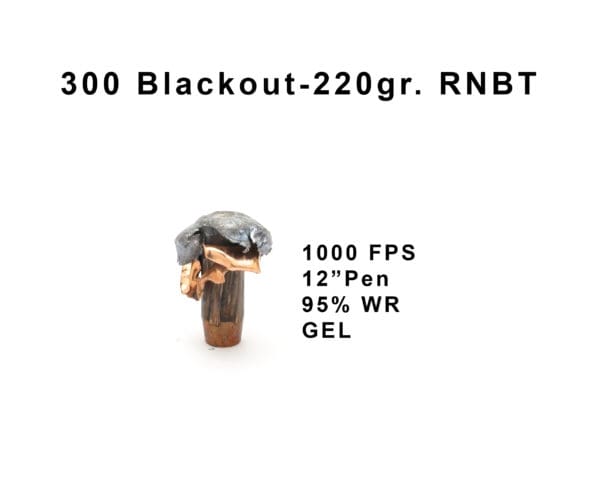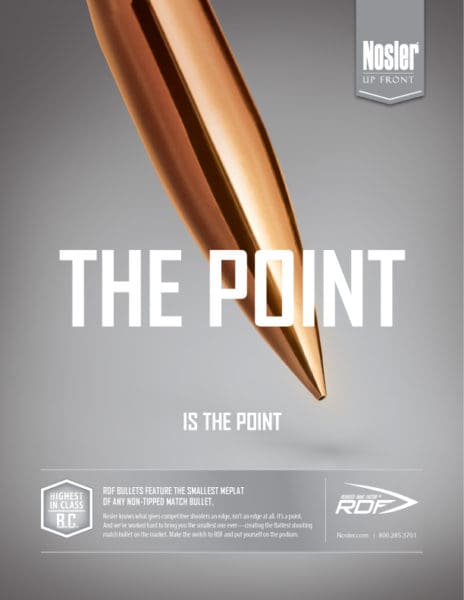
Unlike our man Nick, I’m a bit of a Johnny Come Lately to the whole 300 BLK thing. He got in early and has been preaching it since day one. I sat back and waited, but now that I’ve done it the right way, I see the value. To truly maximize the cartridge, you really do need a short barreled rifle and a silencer.
Those two items checked off, you can happily get to plinking away with subsonic ammo, freed from the constraints of onerous hearing protection devices. But if you wanted to hunt with your new rifle, you would have needed to move up to a much zippier round. Zippier = louder. Louder = less fun.
 To this point, only one other company has tackled the problem of creating reliably expanding bullets meant for low (~1000 fps) velocities. With the introduction of the 220 gr Ballistic Tip from Nosler, you can now make that two companies.
To this point, only one other company has tackled the problem of creating reliably expanding bullets meant for low (~1000 fps) velocities. With the introduction of the 220 gr Ballistic Tip from Nosler, you can now make that two companies.

The Nosler 220 gr RNBT was previously only available as a cobranded Noveske product at $2.00+ per round. Handloaders stamped their feet and made enough noise (my words not Nosler’s) that the Bend, Oregon based company decided to introduce the bullet as a standalone item. Nosler claims that at 1000fps, the RNBT, “reliably exhibits controlled, double-diameter expansion, 90% weight retention and 18” of penetration in ballistic gelatin.”

Color us skeptical for a host of reasons, but Nosler has promised us a case or two of projectiles for some thermal pig hunting this spring so we can do some real world testing.

The other “new” announcement at the 2017 SHOT Show was the introduction of Nosler’s Reduced Drag Factor (RDF) line of bullets designed for the precision rifle shooters of the world. The RDF line is designed as a pure match bullet with a sleek shape that promises to deliver high ballistic coefficients. As you know, higher ballistic coefficients mean less drop and less wind drift.

Nosler’s man on the ground, Zach, tells me that the RDF line is designed with a compound ogive that is insensitive to seating depth allowing for much easier load development. The other major differentiator, and one I was actually able to see on the show floor, is the consistently shaped meplat which Nosler claims is both smaller, and more consistent than any other bullet on the market today.
Both of these points should please match shooters as the cost of high BC bullets seems to be laborious load development, and for the really serious, meplat pointing and trimming. In case you want to read up on the topic, 6mmBR.com has an excellent article on the merits of pointing meplats. Read through it and you’ll understand why the factory taking care of this is such a big deal.
The RDF bullets are in stores now and being offered in the following calibers and weights.
- 22cal – 70gr.
- G1 Ballistic Coefficient – 0.416
- G7 Ballistic Coefficient – 0.211
- 6mm – 105gr.
- G1 Ballistic Coefficient – 0.571
- G7 Ballistic Coefficient – 0.280
- 6.5mm – 140gr.
- G1 Ballistic Coefficient – 0.658
- G7 Ballistic Coefficient – 0.330
- 30cal – 175gr.
- G1 Ballistic Coefficient – 0.536
- G7 Ballistic Coefficient – 0.270
All of the Nosler RDF bullets claim higher BCs than their equivalents from the Target line over at Berger. Given what I know about advertised BC, I’ll withhold judgement until I see some real world results, but if the claimed benefits of easier load development along with higher and more consistent BCs are true, this looks like a great product. Stay tuned for our review.


.300 blk…when you just have to throw dollar bills out of your barrel for 7.62×39 ballistics.
Your 11 inch shorter barrel, yes.
Assuming we’re talking about a non NFA AK-47 with a 16″ barrel, a 6″ .300. Blk would be akin to shooting .357 out of a 2″ barrel. Wasn’t .300 blk designed for performance to be optimal out of a 10 1/2″ barrel ? Also, sub-sonic would be 220 gr. +/- and average 1000 fps. at that point your back down to pistol caliber performance with a rifle projectile with these rounds at what, $2+ a round (probably closer to $3). Cost to performance just tough to justify is all, ESPECIALLY if you’re not shooting sub-sonic suppressed…then it really is almost identical to 7.62×39.
300BLK is great, if you’re a reloader. I make 190gr subs for roughly $0.30/rd (Nosler custom competition 190s can be had <$0.25/bullet) and I make 110gr ballistic tip supers (2500fps) for roughly $0.26/rd (Hornady z-max $0.20-$0.22/bullet). Brass life is great. I don't even count it in my pricing.
So, if you're a factory guy, no, it's not for you. If you're a tinkerer that loves figuring out exactly what you can do (get away with), then it's the perfect cartridge with near infinite possibilities.
Oh, and I shoot half-inch groups @ 100yds with a 10.5″ barrel. I can readily ring steel with subs @ 300, and 500 with supers. Anyone claiming this isn’t an accurate or versatile platform, doesn’t own one and/or can’t hand load.
Not so fast. It more like throwing those bills out your 10mm.
But seriously, you go Nosler. I struggled to find proper slow speed deer hunting rounds for my 300 BLK. Plus I run the top two rounds in the PMAG subsonic and the rest supersonic. I run two sets of sights, aimpoint H1 for subs and offset Magpul mbus pros for supers.
So I welcome new bullets.
Loading a magazine with two different rounds, having two different trajectories and requiring separate sighting systems – sounds like an unnecessary complication to me. For what benefit?
Run 2 sight setups to account for the different bullets. Subs on top so you stay quiet (most animals only get a shot or two sent their way, at that point it’s down or in need of being tracked). If the first 2 shots don’t do the job, the supers come out, which fly faster, straighter, with less drop, and are much more terminally effective.
I would zero the irons for the subs and the red dot for the supers, but other than that it’s actually a really good idea.
Seems like the main reason to hunt with a 300blk is to run subsonic with a suppressor. With archery ballistics, it makes sense to use the primary optic with the main purpose and back up the main purpose with irons. Just a thought.
The 300 BLK can be reloaded. Just use .308 bullets and a 5.56 shell holder. Voila! Cheap rounds.
Don’t be silly, it still costs more to RELOAD .300blk than it does to shoot factory x39.
Yeah, um, OK… Even shooting 150gr FMJ reloads at about what 23-25 cents a round is probably cheaper and just generally a better shooting load than any steel case trash you are buying at 25 cents.
What the 300 BO really needs is a good solid FMJ style120-125gr bullet that people can buy for around 11-13 cents a piece for supersonics that can be loaded for just general screwing around. The Speer TNTs are good bullets, but just a little pricey.
Kudos to Nosler for the 220gr bullets though. Looks very promising.
Winchester also introduced subsonic expanding 300blk (and 308 win) at shot 2017.
I would like to see some tests to see if it would expand down to 900 fps.
There are two other sub .300s for hunting and SD. Lehigh Defense 194 grain and Gorilla Silverback 205 grain both are some kind of expanding projectiles and I believe both are lead free. I also am just getting into the blackout. I have my fingers crossed for the HPA. If not will go the hard way. Went with a CMMG 8.2′ barrel and Superlative adjustable gas block. Should be delivered on Saturday! Midway had the barrel on sale and Primary arms had Fail Zero BCGs and Anderson stripped uppers on sale last weekend!
What 300bo needs is 40 cents a loaded round steel cased plinkying ammo. Thats why my 300bo upper sits on the shelf and the 9mm gets all the love.
What it needs is .25 a round steel ammo so it can compete with 7.26×39. Even at .40 its still a non- starter.
I’m shocked by the concerns about cost per round. But I guess that if you are more interested in your gun making a bang sound than actually hitting the target, the price should be more in line with firecrackers than actual ammunition.
Some people work for a living.
And my x39 AR gets 2moa with R3d army standard so i have no complaints.
I went on ammoseek.com today and found blackout rounds for under .40c. The price has dropped as high demand has more manufacturers competing for the market. It will continue to drop. But .25c per round? The only 5.56 you can find at that price is shitty steel cased ammo. There’s enough people wanting to feed their gun nice brass cased that most people are willing to pay over 30 cents a round to keep that Russian crap out of their guns. Why would the blackout crowd be any different?
An AK or SKS is cheaper and more fun to own but no bragging rights, Evan the lowly Hi-Point Carbine in 9mm or .45 gives about the same or better Ballistics than a 300 subsonic, cheaper means more rounds down range, unless its just a Tactic-cool show and tell!
New rounds are always more expensive while they catch on. There are sub sonics now available under 40 cents a round. 2 years ago they were closer to 80 cents. In a couple years, the rounds till be even cheaper.
This gun was designed to compete with the MP5 and the AK 47. On the MP5, this gun is far less expensive, the blackout round dominates 9mm in terms of ballistics, and gun in subsonic is almost as quiet. The AK 47 is a more difficult cat to conquer as the 7.62X39 is so affordable and just barely superior ballistically. But the ability to use a traditional AR-15 lower, bolt, and magazines makes adding the blackout to your existing collection much more affordable. Being able to easily switch between sub and super sonics is something the AK simply can’t do. And if you like brass rounds, blackout is actually cheaper than brass 7.62X39s.
The question that needs to be asked is: Just how useful are these bullets? To answer that question, we need to know the minimum velocity at which they will reliably mushroom, and the distance downrange where that velocity is reached (assuming subsonic muzzle velocity <1,100 fps).
Do they make your whisper quiet rifle a 300 yard deer killer or not?
Obviously this article was written by a complete newb to the subject.
There is more to choose from than just Lehigh or Nosler.
Outlaw State Bullets LLC.
Makes some of the most accurate subsonic hunting projectiles available, and have been doing so since 2009.
Comments are closed.